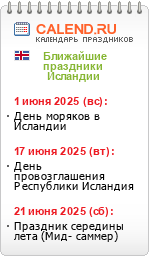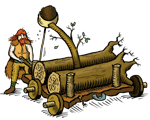Последние темы
Похожие темы
Праздники Исландии

Вход
General Information about Vestmannaeyjar
Страница 1 из 1
 General Information about Vestmannaeyjar
General Information about Vestmannaeyjar
Vestmannaeyjar is a small group of islands off the south coast of Iceland. There are a total of 14 islands in addition to a number of rocks and skerries that make up the archipelago. Only the largest island, Heimaey, is inhabited though several of the outer islands each have a small cabin that is used over the summer during bird hunting season.
Beginnings
The name of the islands, Vestmannaeyjar or Westman Islands, originates from the time when the Irish slaves of Hjörleifur Hróðmarsson who farmed on the south coast, fled to the islands after killing their master at Hjörleifshöfða. Hjörleifur's foster brother, Ingólfur Arnarson, found where the slaves had landed in Vestmannaeyjar and that place still bears the name of Slave Isthmus. To avenge the murder of his brother, Ingólfur hunted down all the slaves and killed them. Locations in Vestmannaeyjar still bear the names from that event, such as Dufþekja on Heimaklettur, the large bluff at the north of the harbor where Dufþakur, the leader of the slaves, is said to have thrown himself from the cliffs in order to avoid being caught by Ingólfur. To the first Icelanders who came from Norway the Irish were known as "West men," thus the name, Westman Islands, after the Irish slaves who were killed there.
There still seem to be a number of unanswered questions about who first settled in Vestmannaeyjar, but the first settler on the island of Heimaey was thought to have been Herjólfur Bárðarson who built his homestead in the valley Herjólfsdalur which was named after him. One of the reasons that particular location was chosen for building a home was that it was one of the few places on the island where fresh water could be found. According to the history book of Landnám, Herjólfur settled on the island around the year 900, but archeological excavations done at the end of the last century indicate that the area had been built up 100 years earlier. Old stories recount that Herjólfur's farmstead was destroyed when it was covered by a landslide.
The fishing industry
From the very earliest times, the islanders have provided for themselves with the bounty that they have sought at sea. Excellent fishing grounds are located very close by and since the island was inhabited, Vestmannaeyjar has always been the country's most profitable fishing harbor. For centuries men rowed in open boats to the fishing grounds using the same equipment of lines and hooks. The most important revolution in working conditions ever seen in Vestmannaeyjar occurred near the turn of the last century. At that time the fishing fleet was motorized and the equipment was extensively improved to enable much larger catches. As a result of these industrial improvements the population of the island grew very quickly in a short time. In 1900 the population was 500, but by 1925 it had increased to 3,200. The largest population recorded was in 1971 standing at 5,200. In 2006 it was 4,200.
In addition to motorizing the fleet and modernizing the fishing equipment, substantial progress was made in how the catch was processed. The most significant innovation was that of freezing the fish, which replaced the older custom of salting it. Today there are two very large processing plants on the island in addition to a number of smaller companies. The larger freezing plants have specialized in processing catches of herring and capelin, as well as lobster. Most of the smaller companies work mainly with fish such as cod, haddock, and pollock among other species. A large portion of the catch is shipped fresh from
Vestmannaeyjar, mostly to European markets.
Farming
The islanders have for centuries also made use of other abundant natural resources besides those provided by the sea. Numerous species of seabirds nest in the steep rock faces along the ocean cliffs and high on the bluffs surrounding the island, and collecting eggs and bird hunting have always been valuable sources of sustenance. Eggs were collected early each spring from the gulls and guillemots, puffins were hunted during the summer months, and towards the end of the summers young gulls and gannets were caught. In the past, fish and bird catches insured that Vestmannaeyjar had a rich abundance of food, more during those times than in many other parts of the country. Some of these traditional food sources are still utilized today.
In addition to fishing and bird hunting, farming was also a part of island life from the earliest times. Farmers raised both sheep and dairy cows and for a long time the islanders were quite self sufficient. Once Icelanders started to grow vegetables such as potatoes and other root vegetables, gardens also became a common sight on Heimaey. During recent years however, farming has become less common though "hobby" farmers still maintain small flocks of sheep and there are horses for riding.
Beginnings
The name of the islands, Vestmannaeyjar or Westman Islands, originates from the time when the Irish slaves of Hjörleifur Hróðmarsson who farmed on the south coast, fled to the islands after killing their master at Hjörleifshöfða. Hjörleifur's foster brother, Ingólfur Arnarson, found where the slaves had landed in Vestmannaeyjar and that place still bears the name of Slave Isthmus. To avenge the murder of his brother, Ingólfur hunted down all the slaves and killed them. Locations in Vestmannaeyjar still bear the names from that event, such as Dufþekja on Heimaklettur, the large bluff at the north of the harbor where Dufþakur, the leader of the slaves, is said to have thrown himself from the cliffs in order to avoid being caught by Ingólfur. To the first Icelanders who came from Norway the Irish were known as "West men," thus the name, Westman Islands, after the Irish slaves who were killed there.
There still seem to be a number of unanswered questions about who first settled in Vestmannaeyjar, but the first settler on the island of Heimaey was thought to have been Herjólfur Bárðarson who built his homestead in the valley Herjólfsdalur which was named after him. One of the reasons that particular location was chosen for building a home was that it was one of the few places on the island where fresh water could be found. According to the history book of Landnám, Herjólfur settled on the island around the year 900, but archeological excavations done at the end of the last century indicate that the area had been built up 100 years earlier. Old stories recount that Herjólfur's farmstead was destroyed when it was covered by a landslide.
The fishing industry
From the very earliest times, the islanders have provided for themselves with the bounty that they have sought at sea. Excellent fishing grounds are located very close by and since the island was inhabited, Vestmannaeyjar has always been the country's most profitable fishing harbor. For centuries men rowed in open boats to the fishing grounds using the same equipment of lines and hooks. The most important revolution in working conditions ever seen in Vestmannaeyjar occurred near the turn of the last century. At that time the fishing fleet was motorized and the equipment was extensively improved to enable much larger catches. As a result of these industrial improvements the population of the island grew very quickly in a short time. In 1900 the population was 500, but by 1925 it had increased to 3,200. The largest population recorded was in 1971 standing at 5,200. In 2006 it was 4,200.
In addition to motorizing the fleet and modernizing the fishing equipment, substantial progress was made in how the catch was processed. The most significant innovation was that of freezing the fish, which replaced the older custom of salting it. Today there are two very large processing plants on the island in addition to a number of smaller companies. The larger freezing plants have specialized in processing catches of herring and capelin, as well as lobster. Most of the smaller companies work mainly with fish such as cod, haddock, and pollock among other species. A large portion of the catch is shipped fresh from
Vestmannaeyjar, mostly to European markets.
Farming
The islanders have for centuries also made use of other abundant natural resources besides those provided by the sea. Numerous species of seabirds nest in the steep rock faces along the ocean cliffs and high on the bluffs surrounding the island, and collecting eggs and bird hunting have always been valuable sources of sustenance. Eggs were collected early each spring from the gulls and guillemots, puffins were hunted during the summer months, and towards the end of the summers young gulls and gannets were caught. In the past, fish and bird catches insured that Vestmannaeyjar had a rich abundance of food, more during those times than in many other parts of the country. Some of these traditional food sources are still utilized today.
In addition to fishing and bird hunting, farming was also a part of island life from the earliest times. Farmers raised both sheep and dairy cows and for a long time the islanders were quite self sufficient. Once Icelanders started to grow vegetables such as potatoes and other root vegetables, gardens also became a common sight on Heimaey. During recent years however, farming has become less common though "hobby" farmers still maintain small flocks of sheep and there are horses for riding.

Гость- Гость
Страница 1 из 1
Права доступа к этому форуму:
Вы не можете отвечать на сообщения|
|
|



» Тиманский овраг
» Отель "Ореанда"
» Карельские рассветы
» Альма-Матер
» Две вдовы Маленького Принца
» Самый сочный шашлык - рецепты, маринады и другие хитрости
» Сентябрь в Алустосе
» Кронштадтский тупик
» Говяжий язык